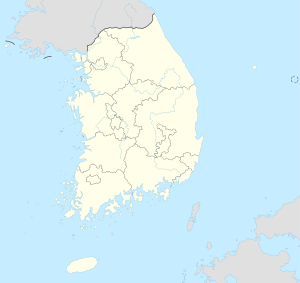Mungyeong
| Mungyeong | |||
|---|---|---|---|
| Korean alphabet : | 문경시 | ||
| Chinese characters : | 聞 慶 市 | ||
| Revised Romanization : | Mungyeong-si | ||
| McCune-Reischauer : | Mun'gyŏng-si | ||
| Basic data | |||
| Province : | Gyeongsangbuk-do | ||
| Coordinates : | 36 ° 36 ' N , 128 ° 12' E | ||
| Surface: | 911.73 km² | ||
| Residents: | 72,924 (as of 2019) | ||
| Population density : | 80 inhabitants per km² | ||
| Structure: | 2 eup, 7 myeon, 5 dong | ||
| map | |||
|
|||
Mungyeong ( kor .: 문경시 , Mungyeong-si ) is a city in Gyeongsangbuk-do Province in South Korea . The city had an area of 911.73 km² and a population of 72,924 people in 2019. Local government, business and transport networks are all concentrated in Jeomchon , the main part of the city. Mungyeong has a long history and is now known for its various historical and scenic tourist attractions. The name of the city means something like "hearing good news".
history
It is believed that the Mungyeong area was controlled by various states during the Samhan period . Geungi-guk Jinhan State may have been near Sanyang-myeon. Byeonhan states like Sabeol-guk and Gosunsi-guk , which likely controlled the Hamchang area of Sangju, may have extended their control to adjacent areas that are now part of Mungyeong. This stage in local history, however, is almost entirely hypothetical, as very little evidence of any kind remains.
In any case, the rising power of Silla controlled the area until 505. Silla took advantage of the territory's strategic potential and built various mountain fortresses in the area to control movements in and out of West Korea. Control of transit through the area would have become even more important after Silla captured the Han River valley on the west side of the mountains in 553. At the time, the low Haneuljae Pass near Poam Mountain was probably the preferred crossing, as opposed to the higher Mungyeong-Saejae Pass, which was favored in the Joseon Period .
When Silla reorganized its administrative structure under Queen Seongdeok in 757 , the area was subordinated to Mungyeong Sangju and divided into different Hyon or local districts. During this time of the united Silla, the temple of Gwaneumsa was built near Haneuljae in what is now Mungyeong-eup, of which everything but a few traces has disappeared.
In the early Goryeo period , in 983, King Seongjong reorganized the local government one more time. Most of Mungyeong remained divided into different hyons under the central jurisdiction of Sangju. Mungyeong-gun (Mungyeong County) appears in the records in 1390, although not with its current boundaries.
In the later Joseon period , the road from Seoul to Busan was laid, which runs over Mungyeong Saejae. From the 18th century gates were built on the road to control traffic and protect travelers from raids. These gates are still preserved today.
The first railways were built in this area during the Japanese occupation. Jeomchon station opened on December 25, 1924. However, the pace of raw material extraction only accelerated considerably in the post-war period under the first South Korean government under the leadership of Rhee Syng-man . The construction of the Gaeun Line with the aim of improving access to the coal deposits around Gaeun began on January 18, 1953, before the official end of the Korean War (the line was completed in 1955).
Local self-government was established in the early years of the Republic of Korea, but abruptly abolished after the 1961 military coup. After the end of the military dictatorship, the local representative government was reinstated in 1991. At that time, the present Mungyeong area was divided between Jeomchon City and Mungyeong County. The city received its current boundaries on January 1, 1995, when the two previous entities were merged to form Mungyeong City.
economy
Mungyeong's economy was based on coal mining for much of the 20th century . However, the mines closed in the 1980s and since then city government has focused on developing tourism, agriculture, and light industry in the area.
Due to its mountainous nature, most of Mungyeong's land (around 75%) is unsuitable for agriculture. Nonetheless, the agricultural sector continues to play an important role in the local economy. Some local products are sold directly in the region, but most of them are exported to the major urban centers of South Korea. Fruit growing, especially apple growing, plays an important role.
The local government has set up various institutions to promote agricultural and industrial development, including "agro-industrial complexes" that are located around the rural districts. These efforts have met with some success, as for example the acreage for orchards was expanded significantly in the late 1990s.
Attractions
Numerous tourist attractions have been advertised throughout Mungyeong City. By far the most famous in the city is the Mungyeong Saejae, the mountain pass where the old road from Busan to Seoul ran over the Sobaek Mountains and out of the Gyeongsangbuk-do region. The three gates that controlled traffic on this street are preserved as tourist attractions today.
The Songnisan National Park is partly located in the urban area.
Web links
- Official website (English)

